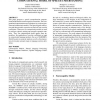Free Online Productivity Tools
i2Speak
i2Symbol
i2OCR
iTex2Img
iWeb2Print
iWeb2Shot
i2Type
iPdf2Split
iPdf2Merge
i2Bopomofo
i2Arabic
i2Style
i2Image
i2PDF
iLatex2Rtf
Sci2ools
AIA
2006
2006
Computational Model of Speech Understanding
This paper proposes a speech comprehension computational model based on neurocognitiveresearches. The computational representation uses techniques as wavelets transform and connectionist models. The speech signal codification and data prosodic extraction are derived from wavelet coefficients. Moreover, the connectionist models are used to perform syntactic parsing and prosodic-semantic mapping. Thus, the computational model applies three approaches: the application of wavelet coefficients as input in connectionist language analysis, the use of SARDSRNRAAM system to syntactic analysis as well as the proposition of prosodic-semantic maps to language contexts definition. KEY WORDS Connectionist Models, Natural Language Processing, Human-Computer Interfaces, Spoken Language Understanding.
| Added | 30 Oct 2010 |
| Updated | 30 Oct 2010 |
| Type | Conference |
| Year | 2006 |
| Where | AIA |
| Authors | Daniel Nehme Müller, Philippe Olivier Alexandre Navaux |
Comments (0)

